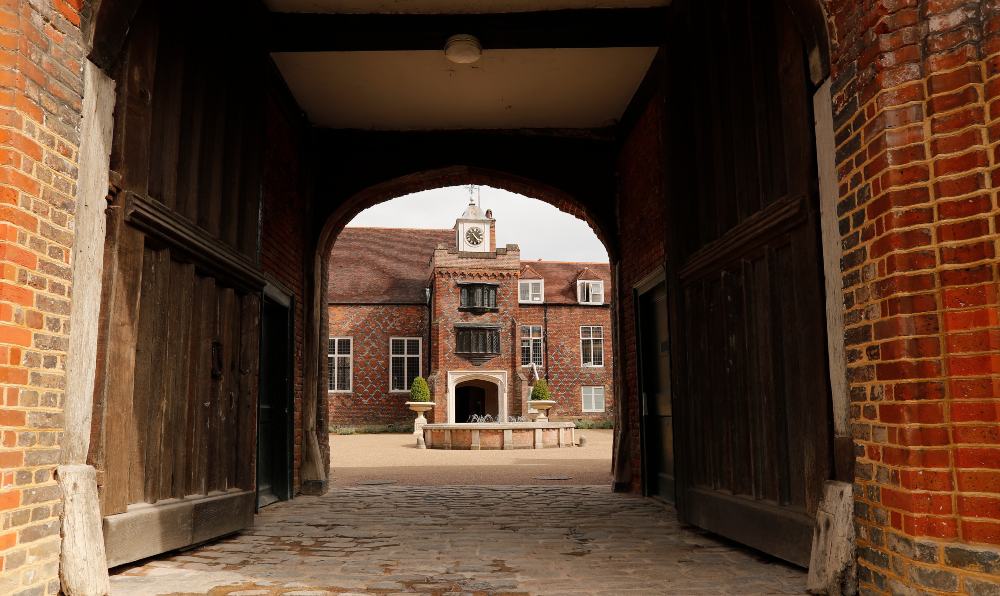
Tales of Fulham Palace
Residence of the Bishops of London from as far back as AD 704, a World War I hospital, a World War II air raid shelter, and haven for kings and queens throughout the ages – Fulham Palace boasts a colourful history
Occupying a sanctuary of lush gardens abutting the greenery of Bishop’s Park on the banks of the Thames, the Palace is one of London’s secret historic masterpieces. Following a major restoration project, the palace officially reopened this summer with a new museum that has doubled in size, a painstakingly restored Tudor courtyard, and expanded gardens that recreate one of the earliest botanical sites of London.
Opened by Her Royal Highness The Duchess of Cornwall just weeks ago, the Palace charts the history of Britain with unique paintings, archaeology and artefacts. Free to visit year round, the restored Palace is the result of a £3.8 million project, including £1.9 million from the National Lottery Heritage Fund and includes historic rooms previously closed to the public.
The Palace’s community archaeologist, Alexis Haslam, explains: “By 2000, the palace was in a really bad way, the roofs were leaking and the restoration projects since then have been really important to get the Palace back onto its feet.”
Royal Connections
The oldest part of the Palace is the Great Hall and Tudor courtyard. An emblem of its rich history, patchwork repairs had previously scarred the brickwork façade but over many months the perished bricks have been restored with new ones made and fired using traditional Tudor techniques.
A new museum occupies the Grand Hall, where visitors can find a treasure trove of archaeological finds. Alexis says: “It’s always exciting when we get the opportunity to excavate at the Palace. The Palace was home to the Bishops of London for more than 1,300 years but there’s earlier activity evident on the site. We have found prehistoric items, a Neolithic axe, late Roman activity and more.”
Along with the Neolithic discoveries, exhibits show the bones of what is believed to be the first turkey in London, Roman pottery and many pieces of early 17th century plaster work. In Bishop Sherlock’s recently restored dining room, two carved faces have been uncovered in the ceiling. Now known to be a way of stamping their identity on the palace – an Instagram of the 1800s – the casts have been found to be Bishop Sherlock, who was Bishop of London from 1748 to 1761, and his wife.
“What’s great is that because the Bishops of London were such important figures, the palace is connected to almost every key moment in British history. Cromwell visited, for example, and Catherine of Aragon is supposed to have stayed here to benefit from the peace, fresh air and tranquil gardens. We run a major schools and education programme and children, families and the public can come and connect with history now in a very tangible way.“
Alexis and the team plan on housing touring exhibitions, which will bring other significant works on loan to the museum along with the plans for more community digs to excavate more of the Palace grounds.
The Palace is also running a calendar of history tours, botanical tours and bee keeping demos, practical gardening demos, family days, outdoor theatre, and kids palace explorer workshops throughout the year. This month’s dates for the diary include outdoor theatre in the shape of The Tempest on 4 August, a musical production of Frankenstein on 29 August, arts and crafts drop-ins on 7,14,21 and 28 August, plus a family ‘bishop for a day’ fun day on 25 August.
Fulham and the Blitz
In more recent history, the Palace was also used as a hospital after World War 1, where soldiers suffering from shell shock were sent to recuperate amid the restful gardens. Their bedrooms were housed in what is now the café and in Bishop Hooley’s dining room.
During the bombing of World War II, Bishop Fisher used to hide in a trapdoor under the library floor, which is still there to this day. The Palace also accommodated members of the Women’s Auxiliary Airforce, who lived above the Palace’s Tudor arch. And during the Blitz, between 200 and 300 local residents sheltered from the bombing at the Palace.
Green Fingers
While many Fulham locals will be familiar with the Palaces restful grounds – its Georgian fronted café and lawn a particularly popular spot on balmy summer afternoons – the Tudor walled gardens are now home to new beds, which recreate the 17th century gardens of celebrated botanist Bishop Compton.
Painstakingly cleared and filled with 80 new species, including ginger, pistachio trees, and Spanish cane, the new beds showcase plants which were all originally grown at the Palace under the keen botanist. Bishop of London from 1675 to 1713, Compton introduced more than 1,000 exotic species of plant to the UK, including the first magnolia in Europe in around 1688, and this legacy is now a celebrated facet of the Palace’s gardens.
Tended to be 54 volunteers (200 volunteers work at the palace as a whole), the lawns, vinery, apple arch orchard, walled gardens and Compton beds are a secret gem in this part of London.
Whether wandering on a summer’s afternoon or wanting to engage little minds with the history on their doorstep, the restored Palace and grounds can now be enjoyed for generations to come.”






